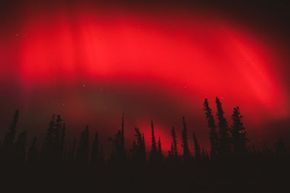What do auroras look like?
As we mentioned, auroras take on different appearances. They can look like an orange or red glow on the horizon -- like a sunrise or sunset. Sometimes they may be mistaken for fires in the distance, like the American Indians thought. They can look like curtains or ribbons and move and undulate during the night.
Auroras can be green, red or blue. Often they will be a combination of colors, with each color visible at a different altitude in the atmosphere.
Advertisement
- Blue and violet: less than 120 kilometers (72 miles)
- Green: 120 to 180 km (72 to 108 miles)
- Red: more than 180 km (108 miles)
After a particularly active solar maximum in the sun's cycle, the red color may appear at altitudes between 90 and 100 km (54 to 60 miles).
Oxygen ions radiate red and yellow light. Nitrogen ions radiate red, blue and violet light. We see green in regions of the atmosphere where both oxygen and nitrogen are present. We see different colors at different altitudes because the relative concentration of oxygen to nitrogen in the atmosphere changes with altitude.
Auroras can vary in brightness. People who regularly observe auroras and report on them generally use a rating scale from zero (faint) to four (very bright). They'll note the aurora's time, date, latitude and colors and make quick sketches of the aurora against the sky. Such reports help astronomers, astrophysicists and Earth scientists monitor auroral activities. Auroras can help us understand the Earth's magnetic field and how it changes over time.
Because the Earth's magnetic field is three-dimensional, the aurora appears as an oval ring around the pole. This has been observed from satellites, the International Space Station and the space shuttle. It isn't a perfect circle because the Earth's magnetic field is distorted by the solar winds.
The auroral ring can vary in diameter. Auroras can be seen as far south as the southern United States, but not frequently. In general, they stay near the polar regions. They also occur in pairs -- when we see an aurora borealis, there is a corresponding aurora australis in the southern hemisphere (learn why on the next page).
